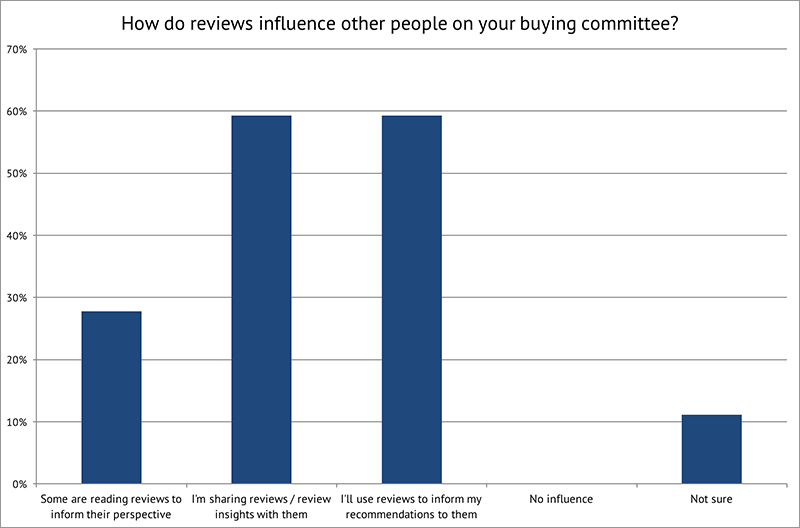
How Reviews Influence Economic Buyers & Buying Committees
When it comes to signing on the dotted line for a new tech product, do reviews influence the economic buyer? In short, yes — sometimes economic buyers read reviews themselves, and sometimes reviews bubble up to them through buying committees. Here’s our full analysis, based on TrustRadius site traffic and registrations, market trends, and survey results.
Which buyers read reviews?
To understand who is being influenced by reviews, let’s first look at who is actually reading them on third-party sites like TrustRadius. (Keep in mind one major caveat: TrustRadius reviews are also consumed beyond our site itself, through syndication to partner and vendor sites.)
About 6 to 10% of the individuals who register to read reviews on TrustRadius are high-level executives, such as CXOs, founders and vice presidents. Because these roles are often considered to be economic buyers, this audience is highly prized by tech marketers. Of course, depending on the company and the type of technology being purchased, this may or may not actually be true. In some cases, managers, directors or any number of roles might make the final decision. According to our latest survey on the purchasing process, 24% of buyers on TrustRadius consider themselves to be the lead buyer, and 9% are the funding approver.
So, while a meaningful chunk of individuals reading reviews on TrustRadius are the economic buyer, the vast majority are more along the lines of program managers, administrators and end-users. The most common purchasing roles for buyers on TrustRadius include identifying and researching options, trialing or evaluating options, and engaging directly with the vendor. These readers play a key role in the purchase process, but may not be the final decision-maker.
The rise of collaborative buying
It is tempting to assume that if 90% of those reading reviews on TrustRadius aren’t executives or funding approvers, then reviews aren’t influencing very many purchase decisions. But that is not the case in today’s increasingly democratic marketplace.
In B2B technology, there’s a clear trend toward more considered and more collaborative purchases, as well as purchase-by-committee, or what the Harvard Business Review calls “the consensus sale.” In a recent survey of buyers using TrustRadius.com, around two-thirds said multiple people at their company are involved in the buying process.
Indeed, popular strategies like account-based marketing are designed to contend with the fact that buying B2B technology has become decentralized. Today multiple stakeholders, sometimes across multiple teams and departments, can be involved in a single purchasing decision.
According to Demand Gen Report’s seventh annual B2B Buyer’s Survey Report, not only are buying groups quite common in 2017, they’re growing in size. More than half of C-level executives, vice presidents, and directors that responded to Demand Gen Report’s survey said more people are now helping to make purchase decisions for their company.
Do reviews influence buying committees?
In our latest survey, 90% of the buyers who were on a committee said reviews influenced other people in their buying group as well. The other 10% simply weren’t sure. Notably, no one answered that reviews had “no influence” on their fellow buyers.

Source: August 2017 Survey of 130 buyers using TrustRadius.com
Almost 60% of survey respondents said they shared reviews or review insights directly with the relevant stakeholders. For example, a committee member may send other stakeholders a review excerpt that discusses their specific use case, or data from reviews may be included in presentations to the committee. These buyers might be invisible to us at TrustRadius, but they are nevertheless directly exposed to and influenced by review content.
Nearly 60% also said they used reviews to inform their recommendations to the rest of the buying group. While the reviews themselves might not be shared, the perspective gained from them helps shape the committee’s conversation about the purchase decision. For example, reviews impact which products make it onto the list of possible candidates or tip the balance in head-to-head comparisons.
How do buying committees actually use reviews?
Based on the variety of responses we received, it is clear that reviews can play many roles in a committee’s purchasing process.
This respondent’s committee used reviews to decide which vendors to engage with:
“Our first step is to identify candidate solutions, from there we will look at reviews and reports to weed out software that does not fit our requirements. Following that process we will move forward with the vendor process, get an idea of pricing and if the software is in budget we will then start a trial.”
Whereas this group read reviews after engaging with vendors, to validate vendor claims and narrow down the purchase options:
“Reviews are VERY HELPFUL to see what issues current users are having with the software, integration with other software, email integration, ease of use, customer service, pricing, etc. The sales staff of the software companies all promise that their software can do all of my feature requirements, so I had to dig down and read reviews on TrustRadius and other sites to get the facts.”
And this respondent, who heads up all stages of evaluation and selection, shares reviews with the rest of the committee and uses reviews to inform their proposals:
“I am the lead researcher, investigator, tech, tester, etc. Once I approve the new technology and get the pricing, I make my recommendation and the person with purchase power either approves, shelves or denies the acquisition.”
The mandate for B2B vendors is clear — there is probably no single buyer you’re trying to influence, economic or otherwise. In fact, the economic buyers themselves are stressing the growing importance of democratic committees in their purchasing decisions. And if any one buyer on the committee is reading reviews, that content is likely to influence the other members of their group.
What can you do to make sure your reviews (and your product) have a seat at the table?
- Build a review base that includes perspectives from multiple roles and departments. Invite end-users, IT users who are involved in implementation or integration, administrators, program managers, consultants, and executive decision makers to review your product. Buyers reading reviews are looking for a range of points of view, as well as reviews from people like them specifically. So variety in your review base will make the data more valuable for committee decision making, and more likely to resonate with individuals on the committee who represent different functions.
- Make sure your reviews are in-depth and engaging. Detailed, balanced, authentic reviews have a better chance of being impactful — especially if you want them to hold water with economic buyers. For example, CIOs see reviews are a promising avenue for unfiltered feedback without the spin, as well as an opportunity to do independent reference checks. But In order to be useful, reviews need to establish trust, which means they need to be detailed and include critical feedback. Your action item here is to make sure you’re using a review site that elicits quality insights, and to invite users who can speak at length about your product.
- Arm your champion with reviews for internal selling. Ask prospects about their team’s goals and biggest concerns, then send them reviews that address those points specifically. Individual reviews can be helpful, or you can send a direct link to a particular topic that’s key for their committee — how your product compares to alternatives, ROI, implementation, ease of integration, etc. Your champion can pass these resources on to their committee as food for thought, or simply use reviews as a supporting citation to bolster their own assessment of your product.




